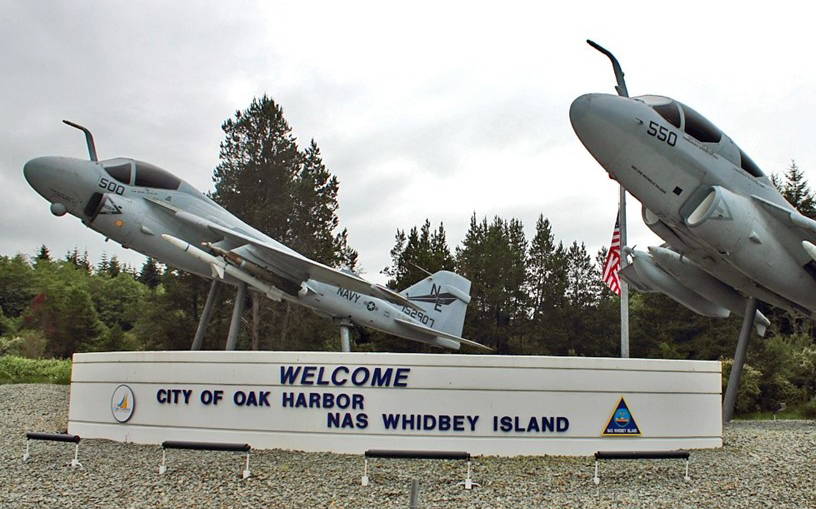Whidbey Island Naval Air Station: Eyes and Ears of the Pacific
By Lookout on Mar 05, 2017 with Comments 1

SLt Rudee Gaudet, Contributor ~
At Naval Air Station (NAS) Whidbey Island in the San Juan Islands, a group of Royal Canadian Navy (RCN) personnel, embedded with the United States Navy (USN), diligently analyze a continuous flow of acoustic data, as they hunt for the telltale signs of submarines.
Operating out of a secure building dubbed by locals as the “prison” for its secure gates and barbed wire fences, they, along with their USN counterparts, are the eyes and ears of the Pacific Ocean.
The prison is the Naval Ocean Processing Facility Whidbey Island (NOPFWI), one of two highly secure USN Integrated Undersea Surveillance Systems (IUSS) facilities in the United States.
A detachment of 37 Canadian Armed Forces (CAF) personnel, consisting of operators, maintenance technicians, and a support cell, work alongside the USN to accomplish the mission of continuous maritime domain awareness.
To achieve their mission, acoustic data is supplied real-time to the NOPFWI watch floor by permanent acoustic sensors on the ocean floor, allied ships, submarines and long-range anti-submarine aircraft around the world.
“Finding a submarine is a big deal here. The entire team on the watch floor is focused on it. From the ships, planes and acoustic sensors to the watch floor, we are using real-time assets to find and track threat submarines 24-hours a day, 365 days a year,” said MS Angelo Aires, a Sonar Operator nearing the end of his posting at NOPFWI.
The CAF has been directly involved in IUSS with allied nations since the 1950s, with joint USN and CAF acoustic processing facilities in Argentia, Nfld., and Shelburne N.S. These were two of over a dozen such facilities in the early days of IUSS, tracking Soviet submarines in the North Atlantic. The facilities would eventually be shut down following the end of the Cold War with service re-directed to other facilities such as NOPFWI.
The RCN has been co-manning NOPFWI since its beginning in 1987.
“RCN members are highly valued here. They arrive with years of exceptional training and experience under their belt,” said LCdr Graham Collins, Commanding Officer of the Canadian Detachment. “NOPFWI located and tracked many threat submarines last year, and when a threat submarine is found, that information is shared with the Regional Joint Operations Centre Pacific.”
The majority of the NOPFWI Canadian Detachment consists of 28 Sonar Operators between the ranks of Leading Seaman (LS) and Petty Officer First Class (PO1) and two Maritime Surface and Sub-Surface (MARS) Officers who serve as Tactical Watch Officers. These 30 RCN members are fully integrated with the USN, staffing the watch floor in various positions.
“Sonar operators will start as sensor operators, the first step in the tracking process. They have the opportunity to move up into different roles such as track reporter and watch supervisor throughout their posting,” explains MS Aires who is currently part of a team of six in the Standards and Evaluation Department of NOPFWI, separate from the watch floor. His job is to implement training simulations and assess both USN and RCN operators in their qualifications.
“We (Sonar Operators) come to NOPFWI from an environment of mostly simulated exercises and training in the RCN, so we have a different level of focus and attention to detail when we have the opportunity to track a real target. We will find and track more submarines in a year at NOPFWI then for the rest of our careers in the RCN; it’s an incredibly rewarding challenge.”
The joint manning of NOPFWI is specifically designed to share oceanographic expertise, experience, assets and professional knowledge between the USN and the CAF.
On the East Coast, south of Virginia Beach, is sister site NOPF Dam Neck, where the USN works with the navy, listening to the Atlantic and sharing information with RJOC Atlantic.
When asked about the importance of underwater surveillance, LCdr Collins compared it to the North American Aerospace Defence Command (NORAD).
“The NOPF sites are the NORAD of the Pacific and Atlantic oceans, just as NORAD knows who is flying in our airspace, we know who is sailing under our oceans.”
Filed Under: Top Stories
About the Author:






As a retired member of the Royal Canadian Navy I was very interested in the article.I was on the air side and spent many hours tracking “Soviet trawlers” with antennas everywhere till you got close. I flew out of Shearwater as well as copter on destroyers. We were 60 miles from Mill Cove (base name for Shelburne location)
Having been born in Argentia and brought up in Freshwater I always liked to have TD there when I was on fixed wing S2F squadron.
Thanks for this informative article. I really don’t believe that people are aware of the military interface program between the countries ARMED FORCES.